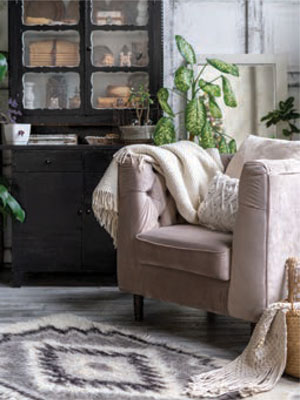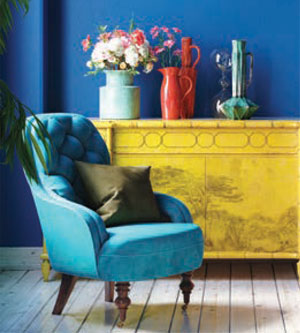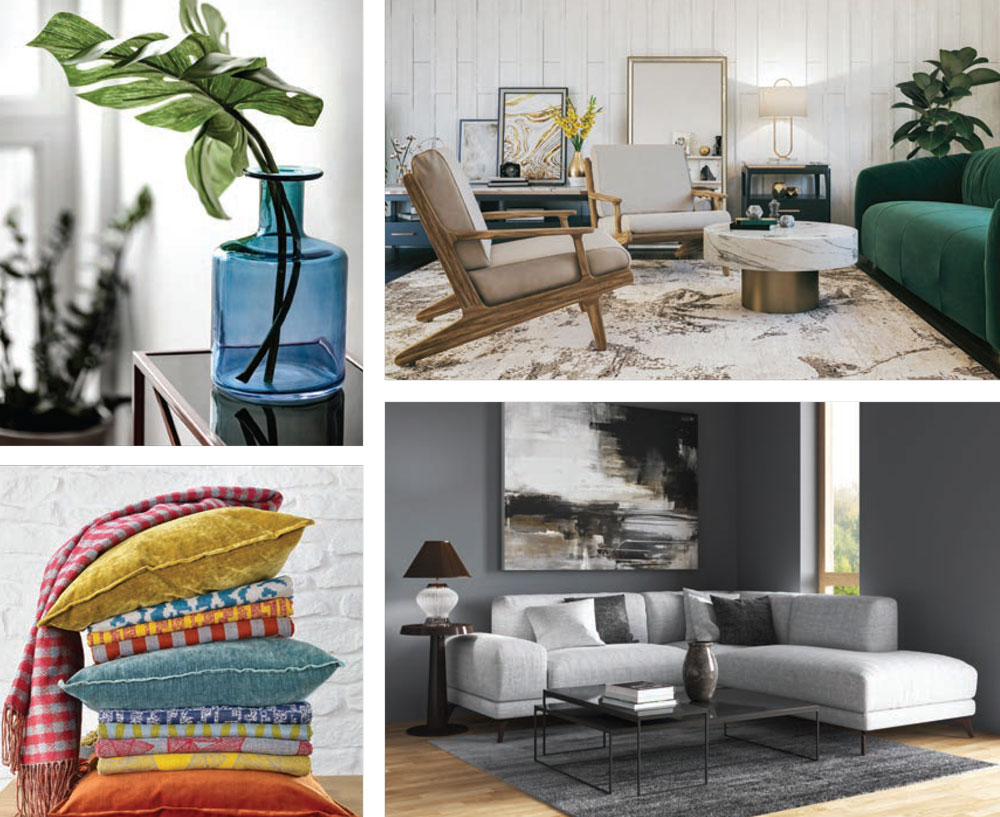Living with Layers | Creating Spaces with Character

We hear it all the time: a well-designed space is all about layers. But what exactly does that mean? Layers of what, and where’s the line between “layer” and “chaos?” The answer is (as always in home design) entirely up to you, but keeping a few tips in mind can help you create layers that are interesting for all the right reasons.
 At its most basic level, layering is using different visual elements to make a room more personal and interesting. The “elements” include colors, shapes, patterns and textures, and “interesting” comes from creating contrast, adding personality, and balancing form and function. It is truly an art form and doing it well is a practice of trial and error, even for the most experienced designers. One of the most prevalent pieces of professional advice is to “stand back and edit” periodically throughout the layering process, which can be ongoing as trends, and you, change.
At its most basic level, layering is using different visual elements to make a room more personal and interesting. The “elements” include colors, shapes, patterns and textures, and “interesting” comes from creating contrast, adding personality, and balancing form and function. It is truly an art form and doing it well is a practice of trial and error, even for the most experienced designers. One of the most prevalent pieces of professional advice is to “stand back and edit” periodically throughout the layering process, which can be ongoing as trends, and you, change.
The first step in any layering operation is establishing a base: what is the main purpose of this room? The main purpose usually dictates the most dominant piece of furniture, such as a bed or a desk. Think of establishing a base as outfitting the room with the bare essentials necessary to function. A good example of this concept is a sofa. It provides seating and comfort in a communal space like a living room or family room, and the necessary base layer is its functional and individualized upholstery. Then, to add some interest and personality, we can add textured or patterned throw pillows in a variety of shapes, and a plush throw in a contrasting color. When you establish a functional base, you can layer whatever you want without compromising the purpose. After that, start working through layers for the room at large.
 One of the first layers to consider in a room is so simple, but can have a dramatic impact: the walls. The color you choose will set the tone for the rest of your layers, so having some idea of the patterns and textures you’re going to include can be helpful but not mandatory. If you’ve found a wallpaper you love, working from the walls out might be the best way to start layering. Try to avoid overwhelming your space, since the walls are likely the largest part of that space; you’ll have to consider other elements in the room (color, pattern and texture) to make sure it all works together. If you’ve decided on a showstopping wallpaper, keep it in mind when selecting other layers; perhaps choose a quieter floor covering or textured, rather than patterned, window treatment. Layering is, at its core, all about balancing the elements. When two or more elements weigh too heavily, the entire space can feel off-kilter.
One of the first layers to consider in a room is so simple, but can have a dramatic impact: the walls. The color you choose will set the tone for the rest of your layers, so having some idea of the patterns and textures you’re going to include can be helpful but not mandatory. If you’ve found a wallpaper you love, working from the walls out might be the best way to start layering. Try to avoid overwhelming your space, since the walls are likely the largest part of that space; you’ll have to consider other elements in the room (color, pattern and texture) to make sure it all works together. If you’ve decided on a showstopping wallpaper, keep it in mind when selecting other layers; perhaps choose a quieter floor covering or textured, rather than patterned, window treatment. Layering is, at its core, all about balancing the elements. When two or more elements weigh too heavily, the entire space can feel off-kilter.
 The next layer to consider is flooring. To an extent, many of us were (or are) unable to really “choose” our floors without a major renovation; we inherited a certain material or color, and the best we can do at the moment is to work around it. Enter: rugs! A rug will quickly and easily anchor the room and alter the vibe for the entire space. For example, a dark jute rug can bring an easy-going, earthy feel to an otherwise polished space, and a traditional Persian rug dresses up an overlooked and high-traffic foyer. Layering rugs is also a great way to create interest, such as placing a neutral cowhide on top of a brightly patterned flatweave rug. Additionally, layering rugs can have a practical benefit; if you love a rug, but find that it’s too small for your space, placing it on top of a complementary larger (and perhaps less expensive!) rug allows you to use the smaller rug as a highlight where it won’t look too small.
The next layer to consider is flooring. To an extent, many of us were (or are) unable to really “choose” our floors without a major renovation; we inherited a certain material or color, and the best we can do at the moment is to work around it. Enter: rugs! A rug will quickly and easily anchor the room and alter the vibe for the entire space. For example, a dark jute rug can bring an easy-going, earthy feel to an otherwise polished space, and a traditional Persian rug dresses up an overlooked and high-traffic foyer. Layering rugs is also a great way to create interest, such as placing a neutral cowhide on top of a brightly patterned flatweave rug. Additionally, layering rugs can have a practical benefit; if you love a rug, but find that it’s too small for your space, placing it on top of a complementary larger (and perhaps less expensive!) rug allows you to use the smaller rug as a highlight where it won’t look too small.
 Occasional furniture and accessories, such as ottomans, cocktail tables, throw pillows and blankets, make up the layer that draws even more interest to a space. Thinking in terms of consistent color is a great starting point, but be sure to also take stock of the layers you already have (Will this kelly-green coffee table be too much on top of this green and blue ikat rug? Will this solid white headboard add enough interest to a bedroom also painted white?). You should also consider how the textures you use will interact with your other layers (Will this matelassé bedding work with the wallpaper?). When it comes to smaller accessories, a bold choice will have a less severe impact on the overall scheme of the room, so you have more risk-taking ability than with larger furnishings.
Occasional furniture and accessories, such as ottomans, cocktail tables, throw pillows and blankets, make up the layer that draws even more interest to a space. Thinking in terms of consistent color is a great starting point, but be sure to also take stock of the layers you already have (Will this kelly-green coffee table be too much on top of this green and blue ikat rug? Will this solid white headboard add enough interest to a bedroom also painted white?). You should also consider how the textures you use will interact with your other layers (Will this matelassé bedding work with the wallpaper?). When it comes to smaller accessories, a bold choice will have a less severe impact on the overall scheme of the room, so you have more risk-taking ability than with larger furnishings.
 LAYERING IS TRULY AN ART FORM AND DOING IT WELL IS A PRACTICE OF TRIAL AND ERROR, EVEN FOR THE MOST EXPERIENCED DESIGNERS. ONE OF THE MOST PREVALENT PIECES OF PROFESSIONAL ADVICE IS TO “STAND BACK AND EDIT” PERIODICALLY THROUGHOUT THE LAYERING PROCESS, WHICH CAN BE ONGOING AS TRENDS, AND YOU, CHANGE.
LAYERING IS TRULY AN ART FORM AND DOING IT WELL IS A PRACTICE OF TRIAL AND ERROR, EVEN FOR THE MOST EXPERIENCED DESIGNERS. ONE OF THE MOST PREVALENT PIECES OF PROFESSIONAL ADVICE IS TO “STAND BACK AND EDIT” PERIODICALLY THROUGHOUT THE LAYERING PROCESS, WHICH CAN BE ONGOING AS TRENDS, AND YOU, CHANGE.
The fun part—the details of lighting, as well as wall and table decor—can be the starting point or the final touch when it comes to layering your space. You may choose Grandmother’s chandelier that you’ve loved all your life to be inspiration for your dining room, or a book collection that must receive star billing in your study, in which case working backwards may be the best option. But adding in these details as you go is a great option, too, and it may be beneficial for those of us trying to figure out the layering process. It also helps create that collected look that gives rooms character. Mixing some old and new, some high-end and low-cost items will make a space diverse and remarkable; every item can tell a story.
Layering is important because it’s the way we turn our houses into homes. Creating layers is how we inject our personality into a space, so it looks different for everyone. Once you’ve established your base, you can begin adding in layers that represent you: your taste, preferences and quirks. ✦
blankets, character, cocktail tables, color, flooring, layers, lighting, ottomans, patterns, personality, rugs, textures, throw pillows, visual elements, walls, well-designed space






